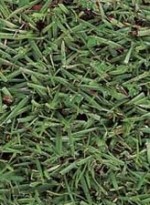 Centipede grass is a light green warm-season grass with medium texture and can make a dense lawn. It spreads by stolons and has shallow roots so is not tolerant of drought, salt spray or wear. In addition, it is slow to establish, and slow to recover from damage and is one of the first grasses to go brown in hot, dry weather and to go dormant in cold weather. In the alkaline soils of the arid west iron deficiencies limit its use. On the positive side, its slow growth means that it doesn’t have to be fertilized or mowed often. It tolerates poor, acid soils and moderate shade, and is fairly pest and disease resistant. It is sensitive to many herbicides used to control weeds in turf but under good conditions centipede grass will choke out weeds. Unfortunately it can can become a weed itself. Relative to other warm-season grasses, however, it is considered low maintenance.
Centipede grass is a light green warm-season grass with medium texture and can make a dense lawn. It spreads by stolons and has shallow roots so is not tolerant of drought, salt spray or wear. In addition, it is slow to establish, and slow to recover from damage and is one of the first grasses to go brown in hot, dry weather and to go dormant in cold weather. In the alkaline soils of the arid west iron deficiencies limit its use. On the positive side, its slow growth means that it doesn’t have to be fertilized or mowed often. It tolerates poor, acid soils and moderate shade, and is fairly pest and disease resistant. It is sensitive to many herbicides used to control weeds in turf but under good conditions centipede grass will choke out weeds. Unfortunately it can can become a weed itself. Relative to other warm-season grasses, however, it is considered low maintenance.
Light: Full sun to light shade
Water: Monitor carefully and water when stressed
Method of Reproduction: sod; sprigs and plugs 1 foot apart in all directions; seed.
Mowing: 1-2” high
Fertilizing: 1-2 pounds nitrogen/1000 sq ft, 3 pounds nitrogen/1000 sq ft on sandy soil; resents excess nitrogen.
Pests and Diseases: Susceptible to brown patch, dollar spot, nematodes.
Outstanding Selections:
-
‘Centiseed’-available as seed
‘Tifblair’-more cold tolerant; available as sod
